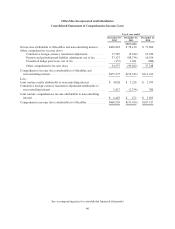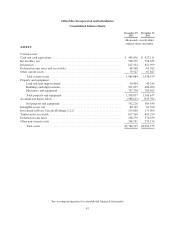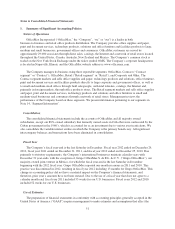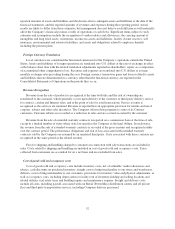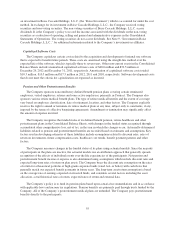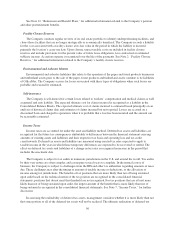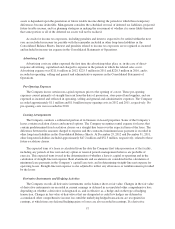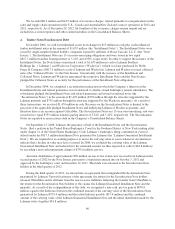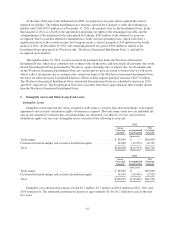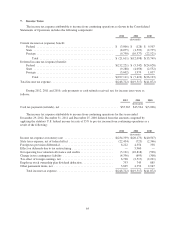OfficeMax 2012 Annual Report Download - page 91
Download and view the complete annual report
Please find page 91 of the 2012 OfficeMax annual report below. You can navigate through the pages in the report by either clicking on the pages listed below, or by using the keyword search tool below to find specific information within the annual report.an investment in Boise Cascade Holdings, L.L.C. (the “Boise Investment”) which is accounted for under the cost
method. In exchange for its investment in Boise Cascade Holdings, L.L.C., the Company received voting
securities and non-voting securities. The non-voting securities of Boise Cascade Holdings, L.L.C. accrue
dividends. It is the Company’s policy to record the income associated with the dividends on the non-voting
securities as a reduction of operating, selling and general and administrative expenses in the Consolidated
Statements of Operations. The voting securities do not accrue dividends. See Note 9, “Investment in Boise
Cascade Holdings, L.L.C.,” for additional information related to the Company’s investments in affiliates.
Capitalized Software Costs
The Company capitalizes certain costs related to the acquisition and development of internal use software
that is expected to benefit future periods. These costs are amortized using the straight-line method over the
expected life of the software, which is typically three to seven years. Other non-current assets in the Consolidated
Balance Sheets include unamortized capitalized software costs of $48.0 million and $32.5 million at
December 29, 2012 and December 31, 2011, respectively. Amortization of capitalized software costs totaled
$10.3 million, $10.5 million and $17.5 million in 2012, 2011 and 2010, respectively. Software development costs
that do not meet the criteria for capitalization are expensed as incurred.
Pension and Other Postretirement Benefits
The Company sponsors noncontributory defined benefit pension plans covering certain terminated
employees, vested employees, retirees and some active employees, primarily in Contract. The Company also
sponsors various retiree medical benefit plans. The type of retiree medical benefits and the extent of coverage
vary based on employee classification, date of retirement, location, and other factors. The Company explicitly
reserves the right to amend or terminate its retiree medical plans at any time, subject only to constraints, if any,
imposed by the terms of collective bargaining agreements. Amendment or termination may significantly affect
the amount of expense incurred.
The Company recognizes the funded status of its defined benefit pension, retiree healthcare and other
postretirement plans in the Consolidated Balance Sheets, with changes in the funded status recognized through
accumulated other comprehensive loss, net of tax, in the year in which the changes occur. Actuarially-determined
liabilities related to pension and postretirement benefits are recorded based on estimates and assumptions. Key
factors used in developing estimates of these liabilities include assumptions related to discount rates, rates of
return on investments, future compensation costs, healthcare cost trends, benefit payment patterns and other
factors.
The Company measures changes in the funded status of its plans using actuarial models. Since the majority
of participants in the plans are inactive, the actuarial models use an attribution approach that generally spreads
recognition of the effects of individual events over the life expectancies of the participants. Net pension and
postretirement benefit income or expense is also determined using assumptions which include discount rates and
expected long-term rates of return on plan assets. The Company bases the discount rate assumption on the rates
of return for a theoretical portfolio of high-grade corporate bonds (rated AA- or better) with cash flows that
generally match our expected benefit payments in future years. The long-term asset return assumption is based
on the average rate of earnings expected on invested funds, and considers several factors including the asset
allocation, actual historical rates of return, expected rates of return and external data.
The Company’s policy is to fund its pension plans based upon actuarial recommendations and in accordance
with applicable laws and income tax regulations. Pension benefits are primarily paid through trusts funded by the
Company. All of the Company’s postretirement medical plans are unfunded. The Company pays postretirement
benefits directly to the participants.
55



